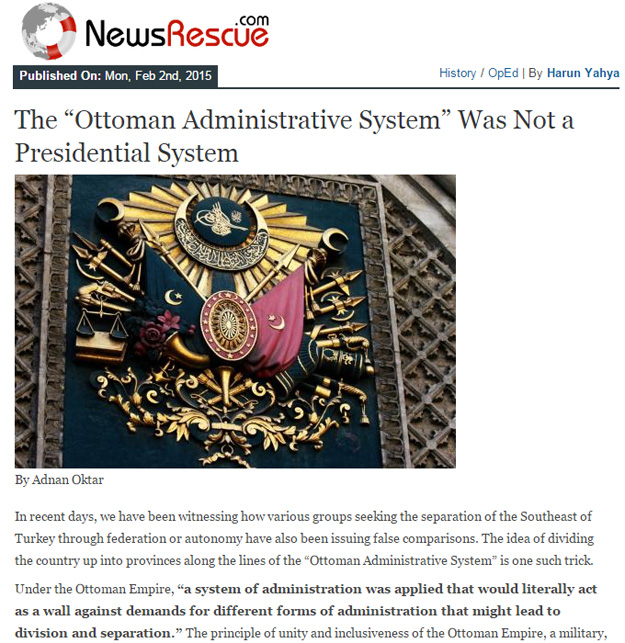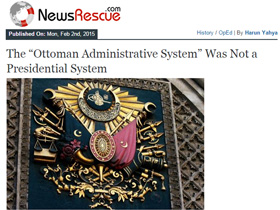
In recent days, we have been witnessing how various groups seeking the separation of the Southeast of Turkey through federation or autonomy have also been issuing false comparisons. The idea of dividing the country up into provinces along the lines of the “Ottoman Administrative System” is one such trick.
Under the Ottoman Empire, “a system of administration was applied that would literally act as a wall against demands for different forms of administration that might lead to division and separation.” The principle of unity and inclusiveness of the Ottoman Empire, a military, economic, cultural, artistic and political superpower of the time, was reflected also in its form of administration. All administrative units, from great to small in the Ottoman Empire, were completely tied to the center: The entire system was built on complete obedience to the Ottoman state. With the conquest of the Mamluk Sultanate of Egypt in 1517, the caliphate passed to the Ottomans. The caliphate was instrumental in dozens of peoples united under the banner of Islam swearing allegiance to the Ottoman Empire.
THE “BEYLERBEY” SYSTEM IN THE OTTOMAN EMPIRE
Administration in the Ottoman Empire was based on the Beylerbey system. The constantly expanding empire referred to the newly added regions (consisting of small cities and towns) as “sanjaks.” The basic administrative system consisted of sanjak governors appointed from the center. Several sanjaks would constitute a Beylerbeylik, or province. Sanjak governors were affiliated to provincial governors known as “Beylerbey” answering to Istanbul; Beylerbeys were appointed by the central authority. There was no question of regions choosing or electing their own governors. The beylerbey in charge of the province was the senior official representing the authority of the sultan.
Beylerbeys were military and civilian officials sent to provincial centers which had the status of “Pasha Sanjak.” In times of peace, beylerbeys were only responsible for their own central sanjaks, while in times of war they had the power to unite all the sanjak governors together under their command and add them to the military.
Many provinces were established in order to ensure order in newly conquered territories. Border security with neighbors with whom the empire was at war was also ensured through the provincial system.
ALL ADMINISTRATORS OF OTTOMAN PROVINCES WERE AFFILIATED TO THE CENTER
In addition to beylerbeys, the heads of the provincial treasuries and “kadis” responsible for administering the law were also appointed from the center. Despite being local administrators, they were answerable to the chief military judge and the head of the Treasury in Istanbul, not to the beylerbeys. The “subashi,” responsible for provincial security and the equivalent of today’s director of security, was also responsible to the central authority in Istanbul. The Beylerbey system was replaced by the “vilayet” system in 1864 as a result of improved technology, transport and communications in the Ottoman Empire.
The Empire reached its maximum extent in 1699 at almost 24 million km2, or almost 30 times the size of modern-day Turkey. Communications were only possible by post messengers. A group of people going on the Hajj from Istanbul would arrive in Mecca only after a journey lasting months. The Beylerbey system was built around bringing order to these regions and for the collection of taxes.
THE KURDS IN THE OTTOMAN EMPIRE
By the 16th century, the Kurds, who were suffering enormously at the hands of the Safavid rule, sought the shelter of the Ottoman Empire. Idris Bitlisi, the leader of one Kurdish tribe, gathered all the Kurdish tribes around Sultan Selim I and fought alongside the Ottomans at the Battle of Chaldiran. With the end of the Safavid threat in 1514, 25 regions predominantly inhabited by Kurdish tribes, including Bitlis, Urmiye, Itak, Imadiye, Cizre, Eğil, Hizran, Garzan, Palu, Siirt, Hasankeyf and Meyyafarikin, swore loyalty to the sultan. From those days until the present, the noble, loyal, devout and highly valued Kurds have been an essential component of the state. The Kurds remained loyal to the caliphate for hundreds of years, attaching no importance to ethnicity, and maintained that loyalty through love of Allah.
KURDISTAN IS NOT A SINGLE PROVINCE
Contrary to what some members of the HDP (Peoples’ Democratic Party [Turkey]) claim, there was never a single province known as “Kurdistan” in the Ottoman Empire. There were a number of separate regions governed by beylerbeys, such as Diyarbekir, Van, Mosul, ar-Raqqah, Erzurum and Aleppo, which were inhabited by Kurds among others. These were not based on one single ethnicity, but on geographical regions. The regions on the map of present-day Turkey are similarly based on geography. The locations of the provinces during the Ottoman era were intended for regional progression of the sultanate.
The Diyarbekir Beylerbeylik occupied only a part of Southeast Anatolia. Part of northern Iraq and northern Syria were affiliated to the beylerbeyliks of ar-Raqqah and Mosul. Lake Van and the surrounding area, with their largely Kurdish populations today, were part of the Van beylerbeylik. At that time, the population was predominantly Armenian, although Turks, Kurds and Arabs also lived within its borders. When the Diyarbekir beylerbeylik was established, the town of Diyarbekir had a population of 15,000, the total population of the beylerbeylik being 180,000. These figures are comparable to those of a medium-sized district today. In addition, there were as many Christians as there were Muslims in the beylerbeyliks of the Southeast. There were no provinces arranged on the basis of a specific ethnicity, religion or sect.
Another important matter is that ethnicity was not even considered when governors were being appointed to these provinces: For example, the Diyarbekir beylerbeylik was governed by 270 different governors in its 352 years of existence between 1515 and 1867. The first beylerbey appointed to Diyarbekir was the Kurd Biyikli Mehmet Pasha, who served for five years. The next appointee was Husrev Pasha, a Bosniak, who also served at the Palace. Damat Rüstem Pasha was Croatian in origin; another pasha, Ayas Mehmet, was of Albanian origins. Numerous governors of all different ethnicities were appointed to Diyarbekir, and all these men served in many other posts both before and after those appointments. In the same way, many Kurds were made governors of other provinces.
Apart from a few exceptions, the people of the region always remained loyal to the sultan and the state. The prevailing belief was always Muslim fraternity, not racial or ethnic superiority. Kurdish tribal leaders and tribes always put the sultan’s decrees before their own interests and egos and they remained genuinely devoted to the caliphate, the state and Islam. That is the fine morality that people who speak of the Ottoman Empire should adopt as a model today.
Those who speak of the provincial system are well aware that the Ottoman provincial system had absolutely nothing to do with the autonomous structure that efforts are being made to establish in the Southeast today. They are trying to give their plans a more respectable appearance by using the name “Ottoman.” That bit of dishonesty is an attempt to deceive our fine nation on the part of the anti-religious, Stalinist, Darwinist/materialist PKK and of Öcalan, the founder of the terror organization.
On the other hand, administrative units such as governorates, district governors, ministries, the prime ministry and the presidency have everything to do with wisdom and good conscience and nothing to do with race and ethnicity. They are all about a person’s faith, quality and culture.
The Anatolian people, be they Turks, Kurds, Laz, Circassians, Albanians and Arabs, have lived together as brothers for more than a thousand years. During that time, common homes were built and our people were welded together as one. The common features of the Turkish nation are its fine morality, spirituality and religious faith: It is far more proper to seek common culture in this notion, rather than dubious ideas of ethnicity. The common cause of our nation, with its 80 million people, is to live as Muslims in a great and powerful Turkey, in unity and brotherhood. The provincial state system, a system that will certainly lead to fragmentation, and thus to destruction and division, is to be scrupulously avoided.
Adnan Oktar's piece on News Rescue:
http://newsrescue.com/ottoman-administrative-system-presidential-system/


